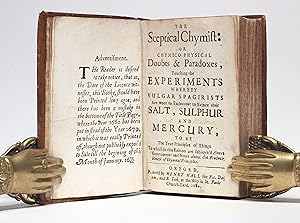About this Item
Two parts in one volume. 8vo (164 x 110 mm). [22], 440, [28], 268 pp., advertisement leaf bound before title in second state with date January 1679/80. Second part with separate title page and pagination. Signatures: [pi]1 A8 a2 (B-2E)8 2F4, *8 2*4 A4 (B-R)8 S4. Bound in 19th century mottled calf, spine with gilt-lettered red morocco label, red-sprinkled edges (upper joint repaired, extremities rubbed). Text generally quite crisp and clean with only minor browning, occasional pale damp-staining at outer margins, some scattered leaves trimmed short at upper margin, occasional minor spotting, small worm tracks at gutter and lower edge affecting a few letters at top inner margin of final 3 gatherings, tiny burn hole in a2 not affecting text, small paper flaw hole in 2E8 w/o loss of letters, clean tear to top margin of F1, paper flaw to fore-margin of 2H2. Provenance: Spero Meleora (old ink inscription on first title), collation notes by Bernard Quarich to rear pastedown. A very good, better than usual, copy. ---- Wing B 4022, Fulton 34, Sparrow 27. PMM 141, Dibner 39, Horblit 14 (for 1st ed.). ENLARGED SECOND EDITION OF A MILESTONE IN THE HISTORY OF CHEMISTRY, WITH THE RARE LEAF OF ADVERTISEMENT and with the second part not present in the original edition of 1661. "The importance of Boyle's book must be sought in his combination of chemistry with physics. His corpuscular theory, and Newton's modification of it, gradually led chemists towards an atomic view of matter . . . His argument was designed to lead chemists away from the pure empiricism of his predecessors and to stress the theoretical, experimental and mechanistic elements of chemical science. The Sceptical Chymist is concerned with the relations between chemical substances rather than transmuting one metal into another or the manufacture of drugs. In this sense the book must be considered one of the most significant milestones on the way to the chemical revolution of Lavoisier in the eighteenth century" (PMM). Written in the form of a dialogue, The Sceptical Chymist presented Boyle's hypothesis that matter consisted of atoms and clusters of atoms in motion and that every phenomenon was the result of collisions of particles in motion. Boyle suspected that none of the then accepted elements - the earth, air, fire and water of the Aristotelians or the salt, sulphur, and mercury of the Paracelsans - was truly elementary. In this work he also defended his corpuscular chemistry, the first clear outline of which he published earlier the same year in Certain Physiological Essays. - Visit our website to see more images! Seller Inventory # 003410
Contact seller
Report this item
![]()




